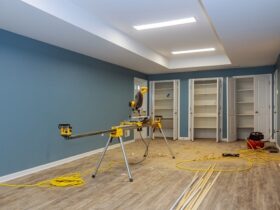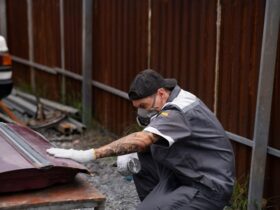Homeownership comes with its fair share of responsibilities, and one of the inevitable aspects is the need for repairs. Whether it’s a leaky faucet, a creaky door, or a cracked wall, addressing these issues promptly is crucial to maintaining a comfortable and functional living space. In this article, we will delve into the world of do-it-yourself (DIY) home repairs, providing you with speedy solutions that are not only effective but also empower you to take matters into your own hands.
The Need for Speed in Home Repairs
When it comes to home repairs, time is often of the essence. Ignoring or delaying repairs can lead to more significant problems and increased expenses down the line. This is where the concept of DIY repairs becomes invaluable. Not only does it save you time and money, but it also gives you a sense of accomplishment. Let’s explore how you can tackle common home repairs swiftly and efficiently.
Essential Tools Every Homeowner Should Have
Before diving into DIY repairs, it’s essential to have the right tools at your disposal. A well-equipped toolbox can make a significant difference in the success of your home repair endeavors. Basic tools such as a hammer, screwdrivers, pliers, and a tape measure are must-haves. With these tools in hand, you’ll be ready to tackle a wide range of repairs around your home.
Quick Fixes for Common Plumbing Issues
Plumbing problems can cause a considerable inconvenience, but many issues can be addressed without the need for a professional plumber. For a leaky faucet, start by turning off the water supply, disassembling the faucet, and replacing the worn-out washer. Clogged drains can often be cleared using a plunger or a mixture of baking soda and vinegar. Remember, tackling plumbing issues promptly can prevent water damage and mold growth.
Instant Solutions for Electrical Problems
Electrical issues at home can be intimidating, but there are several quick fixes that don’t require extensive knowledge. For a tripped circuit breaker, locate the breaker panel, identify the tripped breaker, and reset it. Faulty outlets can often be fixed by tightening loose wires or replacing the outlet altogether. However, it’s crucial to exercise caution and turn off the power before attempting any electrical repairs.
Swift Strategies for Repairing Minor Structural Damage
Minor structural damage, such as small cracks in walls or ceilings, can be repaired with relative ease. Start by cleaning the damaged area and applying a patching compound. Sand the patched area once it’s dry, and finish by painting over it to match the surrounding surface. While these solutions may not be suitable for major structural issues, they can effectively address minor damages.
Efficient Painting and Touch-Up Techniques
A fresh coat of paint can instantly revitalize the appearance of your home. When time is of the essence, focus on high-impact areas, such as the front door or accent walls. For minor damages on walls, such as scratches or small holes, use spackle or joint compound for quick repairs. Remember to choose a paint color that complements the existing décor for a seamless finish.
Rapid Roof Repairs for Leaks
Roof leaks demand immediate attention to prevent water damage to your home’s interior. While a professional assessment and repair may be necessary for extensive damage, you can address minor leaks temporarily. Use roofing cement or a patch kit designed for your roofing material to seal the leak. Consider this a temporary solution until a roofing professional can assess and address the issue comprehensively.
Furniture and Fixture Repairs Made Easy
Every household has its share of furniture and fixtures that undergo wear and tear. Whether it’s a wobbly chair or a loose cabinet handle, these issues can often be resolved with simple DIY repairs. Tighten loose screws, apply wood glue for broken joints, and consider using wood filler for small dents or cracks. Taking the time to address these minor issues can extend the lifespan of your furniture and fixtures.
Tips for Speedy Appliance Repairs
Household appliances are prone to malfunctions, and waiting for a repair technician may not always be feasible. Many common appliance issues have DIY solutions. For instance, a noisy refrigerator could be due to a clogged condenser fan, which you can clean yourself. Refer to the appliance’s manual for troubleshooting tips, and always unplug the appliance before attempting any repairs.
Emergency Flooring Fixes
Flooring issues, such as scratched hardwood or chipped tiles, can be eyesores in your home. Quick fixes for these problems can include using wood filler for scratches in hardwood floors or epoxy repair kits for chipped tiles. Additionally, rugs and furniture placement can help conceal imperfections temporarily while you plan for more extensive repairs or replacements.
Effortless Window and Door Repairs
Windows and doors are susceptible to various issues, from squeaky hinges to drafty seals. Lubricating hinges with silicone spray can often eliminate squeaking. Drafty seals can be addressed by applying weatherstripping. For more extensive repairs, such as replacing a broken window pane or a damaged door frame, consult online tutorials or seek professional guidance.
DIY Solutions for Quick Outdoor Repairs
The exterior of your home is equally important, and quick outdoor repairs can enhance both aesthetics and functionality. Address issues such as loose fence boards, peeling paint on the exterior walls, or a malfunctioning outdoor light. These minor repairs contribute to the overall curb appeal and can prevent more significant problems in the long run.
Safety First: Precautions and Guidelines
While DIY repairs can be empowering, it’s crucial to prioritize safety. Before attempting any repairs, especially those involving electrical or structural components, turn off the power and assess the potential risks. Use personal protective equipment (PPE) as needed, and if in doubt, seek professional assistance. Remember, your safety is paramount.
FAQs
While many DIY repairs are safe, it’s crucial to prioritize safety. Always turn off power before electrical repairs, wear protective gear, and seek professional help for complex issues.
Yes, DIY repairs can save money on labor costs. By addressing minor issues promptly, you can prevent them from becoming more significant and costly problems.
Essential tools include a hammer, screwdrivers, pliers, tape measure, and a well-equipped toolbox.
Use roofing cement or a patch kit designed for your roofing material to seal the leak temporarily. Consult a roofing professional for a comprehensive repair.
Seek professional help for complex issues, such as major structural damage or electrical problems beyond your expertise. Safety should always be the top priority.
Conclusion
Embracing the world of DIY home repairs can save you time, money, and the hassle of waiting for professionals. By arming yourself with essential tools and following step-by-step guides, you can address common issues around your home swiftly and effectively. Remember to prioritize safety, and don’t hesitate to seek professional help for more complex problems. With these speedy solutions, you can maintain a comfortable and well-maintained home with confidence.












Find Us on Socials